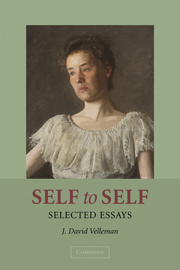Book contents
- Frontmatter
- Contents
- Acknowledgments
- Sources
- 1 Introduction
- 2 A Brief Introduction to Kantian Ethics
- 3 The Genesis of Shame
- 4 Love as a Moral Emotion
- 5 The Voice of Conscience
- 6 A Rational Superego
- 7 Don't Worry, Feel Guilty
- 8 Self to Self
- 9 The Self as Narrator
- 10 From Self Psychology to Moral Philosophy
- 11 The Centered Self
- 12 Willing the Law
- 13 Motivation by Ideal
- 14 Identification and Identity
- Bibliography
- Index
9 - The Self as Narrator
Published online by Cambridge University Press: 21 July 2009
- Frontmatter
- Contents
- Acknowledgments
- Sources
- 1 Introduction
- 2 A Brief Introduction to Kantian Ethics
- 3 The Genesis of Shame
- 4 Love as a Moral Emotion
- 5 The Voice of Conscience
- 6 A Rational Superego
- 7 Don't Worry, Feel Guilty
- 8 Self to Self
- 9 The Self as Narrator
- 10 From Self Psychology to Moral Philosophy
- 11 The Centered Self
- 12 Willing the Law
- 13 Motivation by Ideal
- 14 Identification and Identity
- Bibliography
- Index
Summary
Many philosophers have thought that human autonomy includes, or perhaps even consists in, a capacity for self-constitution – a capacity, that is, to define or invent or create oneself. Unfortunately, self-constitution sounds not just magical but paradoxical, as if the rabbit could go solo and pull himself out of the hat. Suspicions about the very idea of this trick have sometimes been allayed by appeal to the political analogy implicit in the term “self-constitution”: a person is claimed to constitute himself in the same way as a polity does, by writing, ratifying, and revising articles of constitution. But a polity is constituted, in the first instance, by its constituent persons, who are constituted antecedently to it; and suspicions therefore remain about the idea of self-constitution at the level of the individual person.
One philosopher has tried to save personal self-constitution from suspicions of paradox by freely admitting that it is a trick. A real rabbit can't pull himself out of a hat, according to this philosopher, but an illusory rabbit can appear to do so: the secret of the trick is that the rabbit isn't real. We ask, “But if the rabbit isn't real – and there's no magician, either – then who is performing the trick?” He replies, “Why, of course: the hat.” A rabbit can't pull himself out of a hat, but a hat can make it appear that a rabbit is pulling himself out of it.
- Type
- Chapter
- Information
- Self to SelfSelected Essays, pp. 203 - 223Publisher: Cambridge University PressPrint publication year: 2005
- 16
- Cited by

